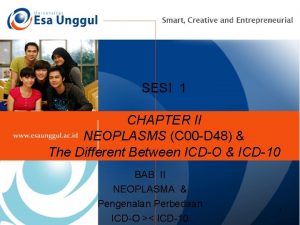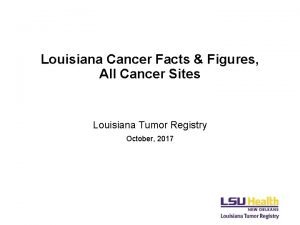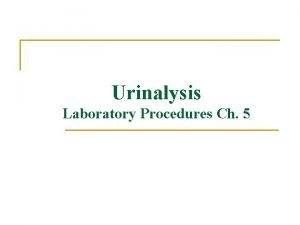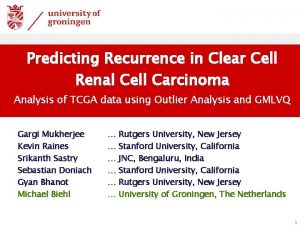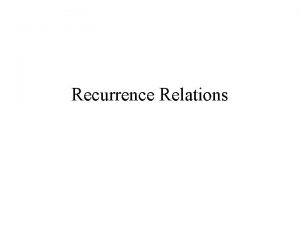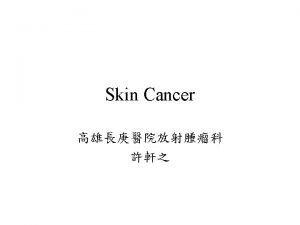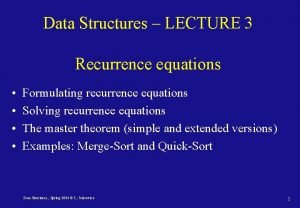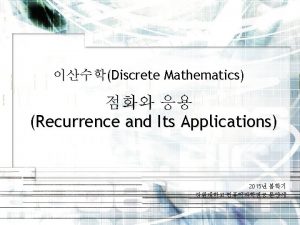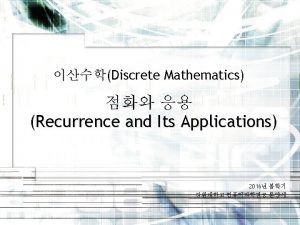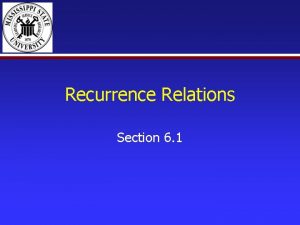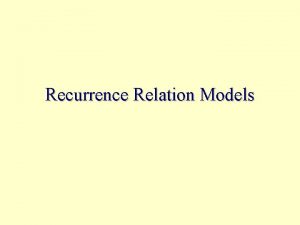Predicting Recurrence in Clear Cell Renal Cell Carcinoma
















- Slides: 16

Predicting Recurrence in Clear Cell Renal Cell Carcinoma Analysis of TCGA data using Outlier Analysis and GMLVQ Gargi Mukherjee Kevin Raines Srikanth Sastry Sebastian Doniach Gyan Bhanot Michael Biehl … … … Rutgers University, New Jersey Stanford University, California JNC, Bengaluru, India Stanford University, California Rutgers University, New Jersey University of Groningen, The Netherlands 1

overview gene expression in tumor cells specific example: clear cell Renal Cell Carcinomas (cc. RCC) clinical data: recurrence free intervals • outlier analysis: identification of a panel of prognostic genes with respect to recurrence • risk score: prediction of individual recurrence risk based on outlier status w. r. t. selected genes • machine learning: analysis of extreme cases of low / high risk distance based classification and relevance learning (Generalized Matrix Relevance LVQ) WCCI 2016, Vancouver / BC 2 /15

data clear cell Renal Cell Carcinoma (cc. RCC) publicly available datasets: The Cancer Genome Atlas (TCGA) cancergenome. nih. gov also hosted at Broad Institute gdac. broadinstitute. org WCCI 2016, Vancouver / BC 3 /15

data 20532 genes 65 normal samples 469 tumor samples clear cell renal cell carcinoma TCGA data @ Broad Institute m. RNA-Seq expression data X normalized, log-transformed: Y=log(1+X) 65 normal samples 65 matched tumor samples 469 tumor samples in total recurrence data: days after diagnosis number of recurrences 65 + 65 matched WCCI 2016, Vancouver / BC 4 /15

outlier analysis 89 test samples 380 training samples randomized split WCCI 2016, Vancouver / BC 5 /15

outlier analysis per gene: determine mean μ, standard deviation σ of Y 380 training samples for each gene: identify outlier samples Y> μ+σ “high outlier“ Y< μ- σ “low outlier“ restrict the following analysis to genes with ≥ 20 high outlier samples or ≥ 20 low outlier samples WCCI 2016, Vancouver / BC 6 /15

outlier analysis Kaplan-Meier (KM) analysis per gene: test for significant association of outlier status of samples with recurrence 1546 „high-outlier genes“ with KM log rank p < 0. 001 1628 „low-outlier genes“ with KM log rank p < 0. 0005 construct two binary outlier matrices 1546 genes 380 samples „ 1“ for high-outlier samples „ 0“ else 380 samples „ 1“ for low-outlier samples „ 0“ else 1628 genes WCCI 2016, Vancouver / BC PCA 7 /15

outlier analysis high outlier genes A 1475 B PCA reveals four clusters of genes 71 low outlier genes C WCCI 2016, Vancouver / BC 1402 D genes in small clusters (B, D): outlier status associated with late recurrence genes in large clusters (A, C): outlier status associated with early recurrence 226 8 /15

recurrence risk score top 20 genes (by KM p-value) from each cluster A, B, C, D reference set of 80 genes for each sample: - determine outlier status with respect to the 80 genes (Y >? < μ ± σ ) - add up contributions per gene - 1 if the sample is outlier w. r. t. to a gene in A or C (early rec. ) 0 if the sample is not an outlier w. r. t. the gene + 1 if the sample is outlier w. r. t. to a gene in B or D (late rec. ) recurrence risk score - 40 ≤ R ≤ + 40 observe: median = 2 over the 380 training samples crisp classification w. r. t. recurrence risk: high risk (early recurrence) if R < 2 low risk (late recurrence) if R ≥ 2 WCCI 2016, Vancouver / BC 9 /15

recurrence risk prediction KM plots with respect to high / low risk groups: training set (380 samples) log rank p < 1. e-16 • • test set (89 samples) log rank p < 1. e-4 risk score R is predictive of the actual recurrence risk the 80 selected genes can serve as a prognostic panel WCCI 2016, Vancouver / BC 10 /15

extreme case analysis number of recurrences: 2 classes: ≤ 2 years (early) (undefined) 109 samples class 2, high risk > 5 years (late or no recurrence) 107 samples class 1, low risk • 80 -dim. feature vectors (gene expression) • representation by one prototype vector per class: • adaptive distance measure for comparison of samples and prototypes: with relevance matrix • distance-based classification, e. g. Nearest Prototype Classifier (NPC) WCCI 2016, Vancouver / BC 11 /15

GMLVQ classifier low expression | high expression Generalized Matrix Relevance Learning Vector Quantization (GMLVQ) training of prototypes and relevance matrix = minimization of an appropriate cost function with respect to performance on labeled training set diagonal elements of Λ components of A WCCI 2016, Vancouver / BC B C D A B C D 12 /15

GMLVQ classifier ROC of GMLVQ classifier (Leave-One-Out of the 216 extreme samples) log rank p < 1. e-7 KM plot w. r. t. all 469 samples ( L-1 -O for 216 samples, plus 253 undefined ) WCCI 2016, Vancouver / BC 13 /15

extreme case analysis (107+109 samples) GMLVQ classifier Risk score classifier - AUC=0. 84 R=2 WCCI 2016, Vancouver / BC 14 /15

diagnostics? the set of 80 genes is also diagnostic: • GMLVQ separates normal from tumor cells (close to) perfectly • PCA of corresponding gene expressions: gradient from normal to high risk: 65 normal samples 105 low risk samples (late recurrence) 109 high risk samples (early recurrence) WCCI 2016, Vancouver / BC 15 /15

remarks and open questions • prospective studies required with respect to use as an assay • 80 genes do not necessarily reflect biological mechanisms compare, e. g. , with known pathways / modules of genes • GMLVQ suggests an even smaller panel of prognostic genes (12? ) identify a minimum panel for diagnostics and prognostics • can the performance be improved further ? study more sophisticated classifier systems include further clinical information (diet, life style, family history, … ) • more direct, multivariate identification of relevant genes ? e. g. PCA+GMLVQ and back-transform easy-to-use GMLVQ-classifier: www. cs. rug. nl/~biehl/gmlvq WCCI 2016, Vancouver / BC 16 /15
 Ira pré renal renal e pós renal
Ira pré renal renal e pós renal Diagnostico etiologico
Diagnostico etiologico Papillary renal cell carcinoma
Papillary renal cell carcinoma Carcinoma renal de células claras fuhrman
Carcinoma renal de células claras fuhrman Renal corpuscle
Renal corpuscle Basal cell carcinoma
Basal cell carcinoma Hedgehog urchin
Hedgehog urchin Squamous cell carcinoma
Squamous cell carcinoma Anaplastic squamous cell
Anaplastic squamous cell Kode icd 10 oat
Kode icd 10 oat Squamous cell carcinoma
Squamous cell carcinoma Squamous cell carcinoma louisiana
Squamous cell carcinoma louisiana Bcc pathology
Bcc pathology Renal tubular cell
Renal tubular cell Neuro derm
Neuro derm Carcinoma de celulas escamosas
Carcinoma de celulas escamosas Endocirne glands
Endocirne glands









